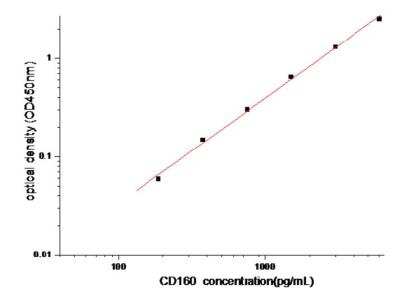CD160 Antibody Pair [HRP]
Novus Biologicals, part of Bio-Techne | Catalog # NBP2-79391
Recombinant Monoclonal Antibody

Key Product Details
Assay Type
Sandwich ELISA
Assay Range
93.75-6000 pg/ml (example only; lot dependent)
Sensitivity
93.75 pg/ml (example only; lot dependent)
Reactivity
Human
Product Specifications
Description
Solid Phase sandwich ELISA for the quantitative determination of Human CD160.
Sample Volume Required
100 ul
Conjugate
HRP
Scientific Data Images for CD160 Antibody Pair [HRP]
Sandwich ELISA: CD160 Antibody Pair [HRP] [NBP2-79391] - This standard curve is only for demonstration purposes. A standard curve should be generated for each assay.
Kit Contents for CD160 Antibody Pair [HRP]
- Rabbit Monoclonal Capture Antibody: (Catalog # NBP2-90073)
- Rabbit Monoclonal Detection Antibody (HRP-conjugated): (Catalog # NBP2-90072)
- Standard
Preparation and Storage
Shipping
The product is shipped with polar packs. Upon receipt, store it immediately at the temperature recommended below.
Stability & Storage
Storage of components varies. See protocol for specific instructions.
Background: CD160
Identified ligands for CD160 include MHC class I proteins and herpes virus entry mediators (HVEM), each of which has a different effect on NK or T cells (1,3-5). CD160 binds to MHC class I proteins with weaker affinity, but the interaction causes NK cell cytotoxic function and cytokine production (1,3). CD160 engagement of MHC class I proteins and/or HVEM within NK cells promotes ERK1/2 and AKT activation and production of interferon gamma (IFNgamma) (5). Conversely, CD160 binding of HVEM in CD4+ T cells induces inhibitory signaling, signifying both a stimulatory and inhibitory role for CD160 as well as cell-specific context (4,5). Additionally, CD160 plays a role in diseases including certain types of cancer, such as thyroid cancer and colon cancer, viral infections, and autoimmune diseases (3,5). CD160 expression levels on CD8+ T cells have been shown to be elevated in chronic viral infections such as human immunodeficiency virus (HIV) and Epstein Barr virus (EBV) (3). In addition, when CD160 is co-expressed with the programmed cell death protein 1 (PD-1) receptor, T cell exhaustion occurs due to persistent stimulation, leading to inhibited immune response and ability to combat infection (3). CD160 may be a promising therapeutic target in cancer as murine studies have demonstrated that blocking the CD160-HVEM pathway causes a regression of neoplastic tumors in a thyroid cancer model (3-5).
References
1. Le Bouteiller P, Tabiasco J, Polgar B, et al. CD160: a unique activating NK cell receptor. Immunol Lett. 2011;138(2):93-96. https://doi.org/10.1016/j.imlet.2011.02.003
2. Uniprotkb (O95971)
3. Piotrowska M, Spodzieja M, Kuncewicz K, Rodziewicz-Motowidlo S, Orlikowska M. CD160 protein as a new therapeutic target in a battle against autoimmune, infectious and lifestyle diseases. Analysis of the structure, interactions and functions. Eur J Med Chem. 2021;224:113694. https://doi.org/10.1016/j.ejmech.2021.113694
4. Cai G, Freeman GJ. The CD160, BTLA, LIGHT/HVEM pathway: a bidirectional switch regulating T-cell activation. Immunol Rev. 2009;229(1):244-258. https://doi.org/10.1111/j.1600-065X.2009.00783.x
5. Sedy JR, Ramezani-Rad P. HVEM network signaling in cancer. Adv Cancer Res. 2019;142:145-186. https://doi.org/10.1016/bs.acr.2019.01.004
Alternate Names
BY55, CD160, NK1, NK28
Gene Symbol
CD160
Additional CD160 Products
Product Documents for CD160 Antibody Pair [HRP]
Product Specific Notices for CD160 Antibody Pair [HRP]
This product is for research use only and is not approved for use in humans or in clinical diagnosis. Antibody Pairs are guaranteed for 6 months from date of receipt.
